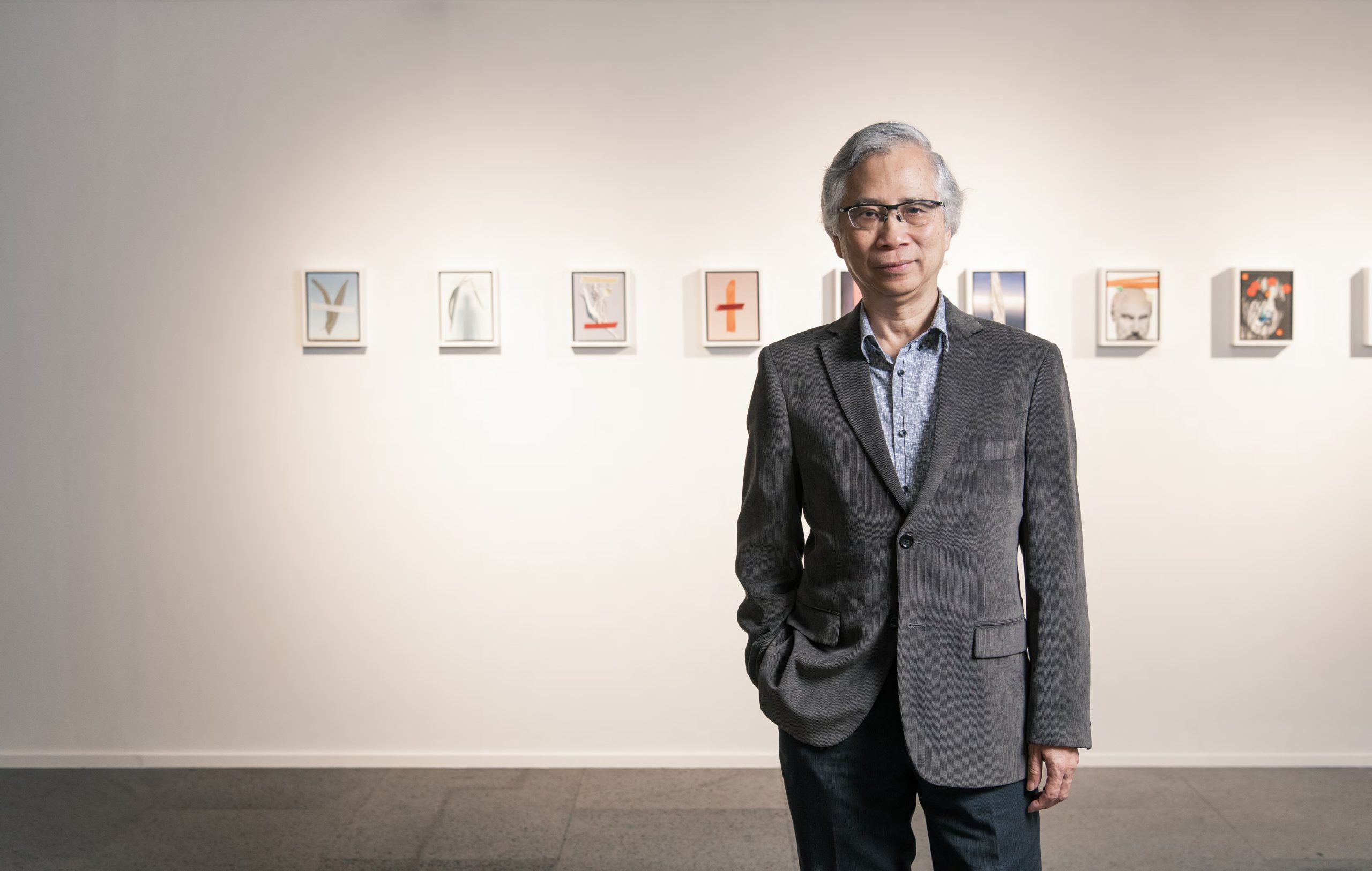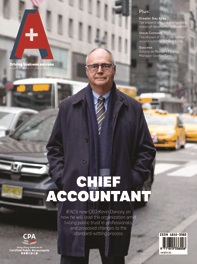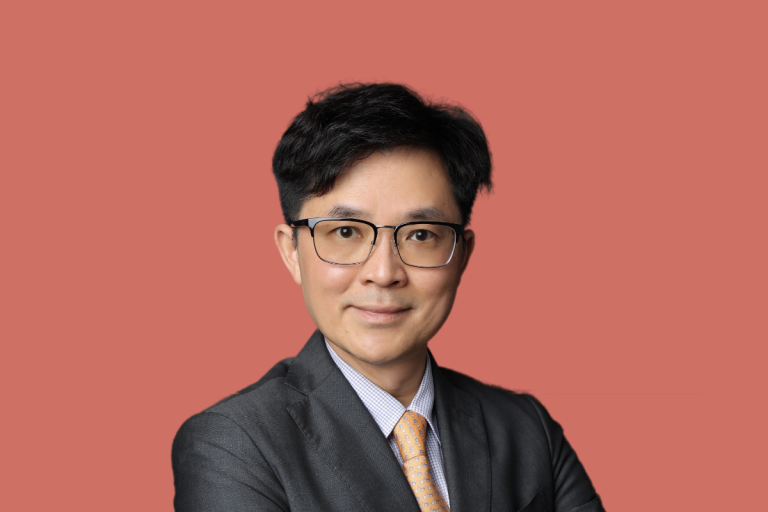George Tong is at home at Galerie du Monde, Hong Kong’s oldest contemporary art gallery. He insists on a tour of the art space in Duddell Street before sitting down to talk. He is both proud and in awe of the ink paintings on display, by artists including Hon Chi-fun, Ha Bik-chuen, and Chui Tze-hung.
Tong’s favourite artist is Zhu Yiyong, who was born in Mainland China’s southwestern city of Chongqing in 1957, and studied at the Oil Painting Department of the Sichuan Academy of Arts. He saw Zhu’s painting Father and Son (1980) in the gallery in the 1990s, and was immediately impressed by his work.
.
But, he has an even more personal connection with Zhu, who had a serious illness in the 1980s. “I also had a serious illness in the 1980s,” says Tong, Finance Manager at Galerie du Monde, and a member of the Hong Kong Institute of CPAs. He had a congenital disorder. After nearly two months in hospital, he returned to work. He has since learned when to take his foot off the pedal. “I need to take care of myself,” he says.
Some of the work at the gallery is from the 1970s – around the time Tong hoped to study art himself. But those dreams were dashed when his parents refused to fund him through art school. “They wanted me to be a white collar worker, an engineer or architect – but not an artist. In their mind then, I would have nothing to eat in the future as an artist,” says Tong.
A dutiful son, he followed their wishes. He studied bookkeeping and accounting in secondary school and attended evening courses in accounting at the Hong Kong Polytechnic University, then known as Hong Kong Polytechnic. But as it turned out, he was destined for a career closely connected to the art world.
For five years, he studied by night and worked at accounting firm Li, Tang, Chen & Co. by day as an audit team leader. “I conducted audit and taxation work for medium-sized companies or affiliates of listed companies.” In 1977, he met Galerie du Monde Founder and Chairman Fred Scholle, a German-American who had set up the gallery three years earlier. The gallery was tucked away on the second floor of a building on Old Bailey Street in Central, and Scholle offered Tong a job managing its finances.
Galerie du Monde specializes in modern and contemporary works by internationally established Chinese artists. The galIery also nurtures and promotes emerging talent, presenting solo and group exhibitions with a focus on works of art on canvas, paper, sculpture, photography and new media. It also offers museum-standard framing, and art conservation and repair.
“Art Basel draws so many top galleries from around the world, and it brings in so many artists with different styles. It’s the highlight of our year.”
The gallery has been represented at Art Basel Hong Kong, one of the biggest annual art events, since its inception in 2013, and also attends the overseas fairs. Tong is looking forward to the art fair, which takes place this month. “Art Basel draws so many top galleries from around the world, and it brings in so many artists with different styles. It’s the highlight of our year,” says Tong.
When Tong started out in accounting in the 1970s, he sat the exams of the Association of International Accountants, a United Kingdom-based global accounting body. Just before the 1997 handover, he transferred membership from the British body, and became an Institute member. “The Institute is the biggest association for accounting in Hong Kong and is well-accepted in the market. My boss (Scholle) was very happy. He said, ‘oh George, you finally got recognition from the Hong Kong accounting body,’” remembers Tong.
His role is to control the buying and selling. “I can’t advise which paintings will sell or not, but I can tell the gallery how much money we have to invest or when we have to stop investing,” he says. “As the finance manager, I have to keep my eyes on the cash flow for the acquisition of expensive trading stocks, and I also have to give advice on the gallery’s participation in various international art fairs.”
Tong believes his skills as a CPA help him deal with tricky situations at work. “I use my accounting and financial knowledge to manage the fund flow of the company in order to achieve a better investment return.”

In 1977, George Tong was offered the job of managing finances for Galerie du Monde by its Founder and Chairman Fred Scholle. Tong is pictured here in front of the work of Australian artist, Juan Ford.
Hong Kong’s art boom
The 1970s and early 1980s was a good time for the Hong Kong economy, which fed through to the art world as people began buying paintings. As Galerie du Monde grew, it needed more space, and moved in the early 1980s to a more prominent location on 26 Hollywood Road, near the Central Police Station, now Tai Kwun Centre for Heritage and Arts.
Following the move to Hollywood Road, sales doubled. It was in that location for about 10 years before moving to Pacific Place in 1988 for 19 years and then to its current home in the Ruttonjee Centre since mid-2007.
Tong recalls the excitement of helping to establish a street-level gallery. “Working as an accountant, I was new to decoration and design. We decided to divide the space into three levels – my boss thought I was crazy. You first entered a small exhibition area for paintings, then the second entrance was a little higher with sliding panels to show more paintings, and then the framing counter on the third level,” he says.
“Without the framing business we wouldn’t have had the money to buy that kind of art.”
The framing division is at the very heart of the business. In the early days, it accounted for 60 percent of the revenue, although Tong estimates it is now about 50 percent, adding that paintings go for higher sums. There were few custom-framing shops in Hong Kong in the 1980s and demand was strong. Recognizing the value to the business, Scholle went overseas to study framing techniques and passed those skills on to his local team.
“Fred Scholle, who was familiar with the expat market, knew that expats wanted to have their paintings framed well. An unframed painting might not look that great, but when you frame it and set it off with an edge, it looks much better, and you can sell it for more,” says Tong.
The framing division gives stability to the business. While it’s not every day that the gallery sells a painting, the framing section receives steady orders.
Tong works out of the gallery’s Ap Lei Chau back office and often slips upstairs to the 8,000-square-foot framing workshop. “There are about 10 framers, and I like chatting to them and looking at the paintings. Without the framing business we wouldn’t have had the money to buy that kind of art,” he says.

Tong says the gallery’s framing division gives the business stability.
Getting recognized
With each location move, the gallery – and Hong Kong’s art market – has grown, says Tong. “People in Hong Kong are getting richer, and many realize that investing in art is better than keeping money in the bank. Some paintings have tripled in value or even more,” he adds. “A lot of people are buying not just for decorative purposes, but for investment.”
The gallery invests in its artists, and spends money to promote them and send them overseas, and has earned a reputation for promoting Mainland Chinese talent. The gallery’s Managing Director, Kelvin Yang, plays a key role in nurturing new talent, according to Tong. “Kelvin was born in Mainland China and knows the China market very well. He socializes with the artists there. Once the artists know about us, they refer us to their friends.”
Negotiating contracts with artists today is nothing like it was in the 1970s. When Tong joined the gallery, he recalls Chinese artists preferring to sell all their artwork in one go, to get instant liquidity. That all changed in the 1990s. As demand for Chinese art grew, artists began demanding better terms. “At the time, artists were quite poor. They would have a lot of paintings in their house, and we would buy the whole lot in one purchase. They didn’t want to sell one or two paintings, or sell on consignment,” he says.
Tong believes that art offers a good escape and a chance to relax the mind. He hopes that other accountants will see the merits of art appreciation. “Sometimes, to relax, I look at a painting. Each time I look at a piece of art, I see it differently – it depends on how my imagination and my mood interpret the work,” he says. “If you don’t buy the painting, at least have a look at it so you can free your mind. I encourage accountants to spend more time looking at art – it will give them good health.”
















